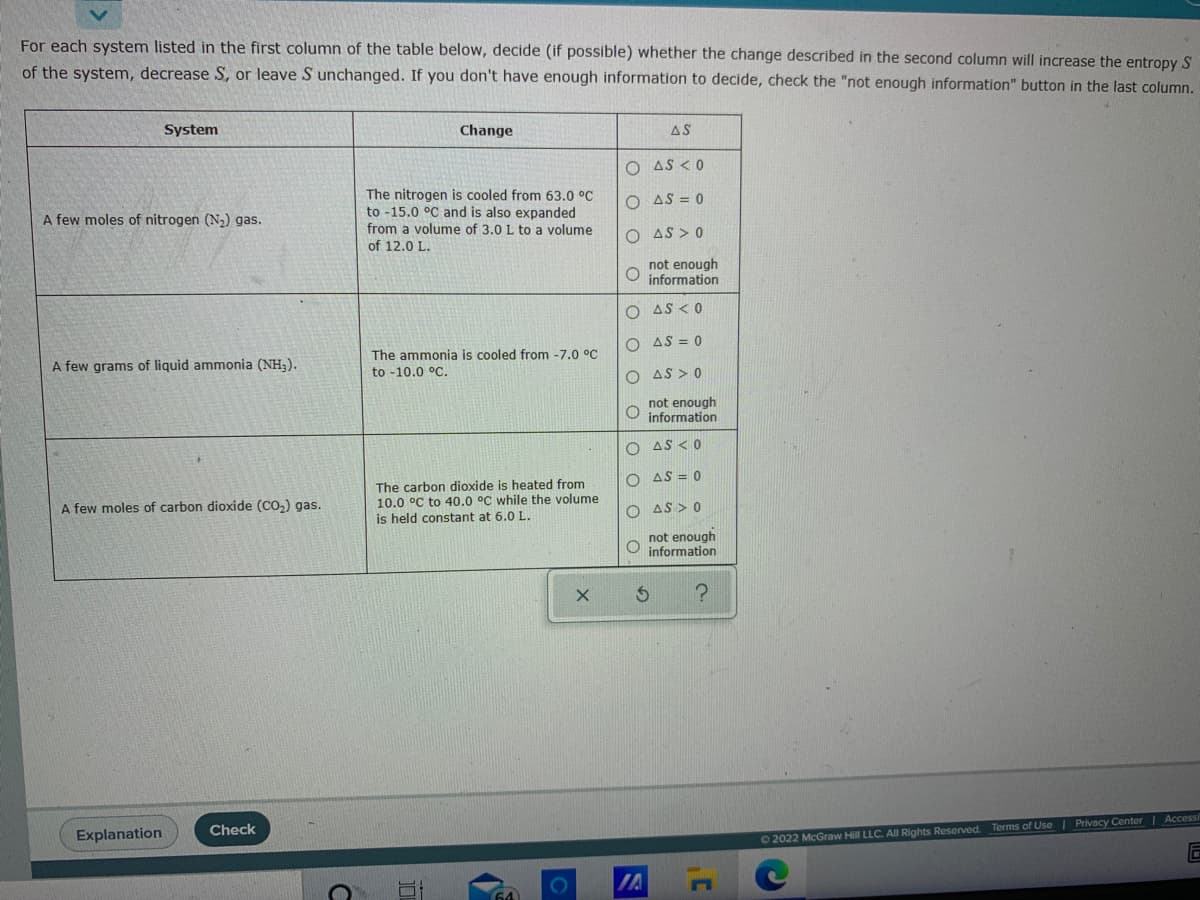For each system listed in the first column of the table below, decide (if possible) whether the change described in the second column will increase the entropy S of the system, decrease S, or leave S unchanged. If you don't have enough information to decide, check the "not enough information" button in the last column System Change AS O AS < 0 The nitrogen is cooled from 63.0 °C to -15.0 °C and is also expanded from a volume of 3.0 L to a volume O AS = 0 A few moles of nitrogen (N,) gas. O AS > 0 of 12.0 L. not enough O information O AS <0 O AS = 0 The ammonia is cooled from -7.0 °C A few grams of liquid ammonia (NH,). to -10.0 °C. O AS > 0 not enough information O AS < 0 O AS = 0 The carbon dioxide is heated from 10.0 °C to 40.0 °C while the volume is held constant at 6.0 L. A few moles of carbon dioxide (CO,) gas. O AS > 0 not enough O information O O
For each system listed in the first column of the table below, decide (if possible) whether the change described in the second column will increase the entropy S of the system, decrease S, or leave S unchanged. If you don't have enough information to decide, check the "not enough information" button in the last column System Change AS O AS < 0 The nitrogen is cooled from 63.0 °C to -15.0 °C and is also expanded from a volume of 3.0 L to a volume O AS = 0 A few moles of nitrogen (N,) gas. O AS > 0 of 12.0 L. not enough O information O AS <0 O AS = 0 The ammonia is cooled from -7.0 °C A few grams of liquid ammonia (NH,). to -10.0 °C. O AS > 0 not enough information O AS < 0 O AS = 0 The carbon dioxide is heated from 10.0 °C to 40.0 °C while the volume is held constant at 6.0 L. A few moles of carbon dioxide (CO,) gas. O AS > 0 not enough O information O O
Chemistry & Chemical Reactivity
10th Edition
ISBN:9781337399074
Author:John C. Kotz, Paul M. Treichel, John Townsend, David Treichel
Publisher:John C. Kotz, Paul M. Treichel, John Townsend, David Treichel
Chapter18: Principles Of Chemical Reactivity: Entropy And Free Energy
Section18.7: The Interplay Of Kinetics And Thermodynamics
Problem 2.2ACP: It has been demonstrated that buckminsterfullerene (C60), another allotrope of carbon (Section 2.3),...
Related questions
Question

Transcribed Image Text:For each system listed in the first column of the table below, decide (if possible) whether the change described in the second column will increase the entropy S
of the system, decrease S, or leave S unchanged. If you don't have enough information to decide, check the "not enough information" button in the last column.
System
Change
AS
O AS < 0
The nitrogen is cooled from 63.0 °C
to -15.0 °C and is also expanded
from a volume of 3.0 L to a volume
A few moles of nitrogen (N2) gas.
O AS = 0
of 12.0 L.
O AS > 0
not enough
information
O AS <0
O AS = 0
The ammonia is cooled from -7.0 °C
to -10.0 °C.
A few grams of liquid ammonia (NH,).
O AS > 0
not enough
O information
O AS < 0
O AS = 0
The carbon dioxide is heated from
10.0 °C to 40.0 °C while the volume
is held constant at 6.0 L.
A few moles of carbon dioxide (CO,) gas.
O AS > 0
not enough
information
Explanation
Check
02022 McGraw Hill LLC. All Rights Reserved. Terms of Use Privacy Center Accessi
IA
64
Expert Solution
This question has been solved!
Explore an expertly crafted, step-by-step solution for a thorough understanding of key concepts.
Step by step
Solved in 2 steps with 2 images

Knowledge Booster
Learn more about
Need a deep-dive on the concept behind this application? Look no further. Learn more about this topic, chemistry and related others by exploring similar questions and additional content below.Recommended textbooks for you

Chemistry & Chemical Reactivity
Chemistry
ISBN:
9781337399074
Author:
John C. Kotz, Paul M. Treichel, John Townsend, David Treichel
Publisher:
Cengage Learning

Chemistry: The Molecular Science
Chemistry
ISBN:
9781285199047
Author:
John W. Moore, Conrad L. Stanitski
Publisher:
Cengage Learning

Chemistry by OpenStax (2015-05-04)
Chemistry
ISBN:
9781938168390
Author:
Klaus Theopold, Richard H Langley, Paul Flowers, William R. Robinson, Mark Blaser
Publisher:
OpenStax

Chemistry & Chemical Reactivity
Chemistry
ISBN:
9781337399074
Author:
John C. Kotz, Paul M. Treichel, John Townsend, David Treichel
Publisher:
Cengage Learning

Chemistry: The Molecular Science
Chemistry
ISBN:
9781285199047
Author:
John W. Moore, Conrad L. Stanitski
Publisher:
Cengage Learning

Chemistry by OpenStax (2015-05-04)
Chemistry
ISBN:
9781938168390
Author:
Klaus Theopold, Richard H Langley, Paul Flowers, William R. Robinson, Mark Blaser
Publisher:
OpenStax

Chemistry for Engineering Students
Chemistry
ISBN:
9781285199023
Author:
Lawrence S. Brown, Tom Holme
Publisher:
Cengage Learning

Chemistry: Principles and Practice
Chemistry
ISBN:
9780534420123
Author:
Daniel L. Reger, Scott R. Goode, David W. Ball, Edward Mercer
Publisher:
Cengage Learning
